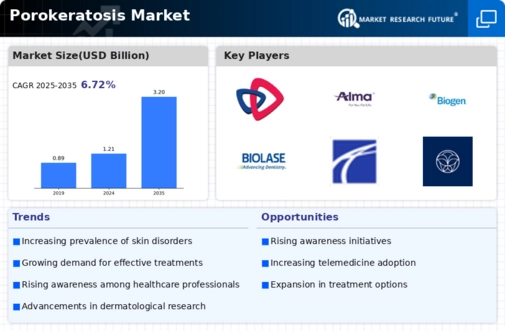Market Trends
Key Emerging Trends in the Porokeratosis Market
Recent years have seen notable changes in the market trends of porokeratosis, a skin disorder characterized by small raised bumps with a distinct border. In particular, there has been an increase in awareness and diagnosis of porokeratosis resulting to a growing patient population looking for medical attention. This increased awareness is due to education programs, better access to health care information, and the increasing diagnostic capabilities within most healthcare systems.
Diagnostic developments are critical in the changing porokeratosis market landscape. The use of more accurate and efficient diagnostic tools such as molecular testing and dermatopathology techniques has enabled clinicians to diagnose porokeratosis more accurately. Early detection and appropriate management are necessary for this trend to improve on patients’ outcomes as well as their quality of life.
Treatment options for porokeratosis have experienced significant breakthroughs on one side together with a move towards targeted treatments as well as minimally invasive interventions. Commonly used topical therapies include retinoids and keratolytic agents which help alleviate symptoms and support skin healing processes. In addition, laser therapy or cryotherapy may be utilized effectively in management of these lesions; hence offering less invasive alternatives when compared to traditional surgical approaches.
One major trend within the field of therapies aiming at treatment of Porokeratosis is that pharmaceutical companies are concentrating more on research and development activities. Collaborations between drug makers, universities/colleges as well as research institutions seek ways through which unmet medical needs associated with Porokeratosis can be addressed. This collation therefore helps explore novel therapeutic agents such as immune modulators and targeted biologics which could transform Porokeratosis treatment altogether.
Similarly, another noticeable development aiming at improving healthcare provision is technology integration into patient care continuum. Remote consultations, following up on patients remotely, remote monitoring can all take place via digital health solutions like telemedicine among others. Additionally given the impact made by COVID-19 pandemic, this trend is also gaining momentum as it is leading to improved access and convenience of treatment seeking for people with Porokeratosis.
Patient advocacy and support networks are playing a very crucial role in the porokeratosis market. With increased awareness, patients and their families are looking for resources, information, and emotional help. Advocacy organizations are actively sensitizing the public, they drive research initiatives and create an environment where affected persons can share experiences about porokeratosis.
Regulatory authorities also play a role in shaping the porokeratosis market. There is more favorable regulatory environment due to efforts aimed at shortening approval processes for new treatments increasing patient safety measures as well as promoting research in this area. The proactive nature of these regulatory authorities increases chances of having innovative therapies enter into the market which could be beneficial to individuals suffering from Porokeratosis.













Leave a Comment